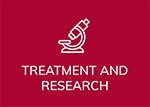Dr. David Cucchi and colleagues presented this research at the American Society for Hematology annual meeting, which was held in December 2021 (ASH 2021).
Background:
The American Society for Hematology (ASH) annual meeting is one of the major conferences where leukemia and lymphoma research is presented. Researchers submit abstracts, which are brief summaries of the research they will present at the conference. Reports of “positive” results in early phase trials presented at ASH presumably represent therapeutic advances with potential for further confirmatory testing in larger, randomized trials. But what happens after the abstract is presented at the meeting? Do the phase 2 regimens presented at ASH move on to larger phase 3 trials that inform clinical practice? Is the information presented at the meeting getting written into more detailed full papers that other scientists can review? Researchers wanted to quantify how many ASH abstracts led to the publication of full papers and/or phase 3 clinical trials.
As a reminder, phase 2 clinical trial tests the efficacy of a therapy in usually less than 100 patients, and there may be no control group. A phase 3 clinical trial may enroll hundreds to thousands of patients, and the new treatment is compared with a current standard of care to see if it is any better. Phase 3 trials are generally required before a new therapy is approved by the FDA and other government regulatory agencies. However, some treatments may receive provisional approval based on strong phase 2 results., but the phase 3 trial still must be completed for full approval.
For more on these topics, please read Clinical Trial Phases, the Drug Approval Process, and Measuring Responses.
Takeaways:
- The researchers evaluated all abstracts reporting phase 2 clinical trials (N = 371) of novel drugs and therapeutic regimens presented at ASH between 2013 and 2015.
- They scored abstracts as “positive”, “negative”, or “inconclusive”.
- 80% of abstracts were positive, 10% were negative, and 10% were inconclusive.
- 79% of the studies went on to be published in peer-reviewed journals.
- The abstract conclusion (positive, negative, or inconclusive) was not associated with publication in a peer-reviewed journal.
- Sometimes the abstract conclusion differed from the later peer-reviewed publication. For example, of positive ASH abstracts, 6% changed to a negative conclusion in the peer-reviewed publication. Similarly, 6.5% of the initial negative abstract was later reversed to a positive conclusion.
- 53% of positive abstracts did not lead to phase 3 studies
- The reasons for not proceeding to phase 3 trials included:
- The decision by the pharmaceutical company to halt clinical investigation (44%),
- Lack of any intent to study the drug in phase III in the first place (40%),
- Insufficient funding (35%),
- Insufficient efficacy (despite the “positive” abstract; 33%)
- Safety concerns (4%).
Conclusions:
Most phase 2 clinical trials reported as ASH abstracts go on to be published as full papers in peer-reviewed journals, with “positive” and “negative” ASH abstracts published as full papers equally often. However, there is likely a tendency to submit (and/or accept) positive, rather than negative, studies to ASH in the first place, given that 80% of ASH abstracts were “positive.” Over half of the regimens presented at ASH remain unevaluated in phase 3 trials. This means that much promising research about new treatments is not moved forward, and thus it never determined whether it might improve outcomes. Business reasons are often the determining factors in the decision whether to spend the tremendous time and money needed to make a new therapy available.
Here is the link to the ASH 2021 abstract for more details.
Take care of yourself first.
Ann Liu, PhD

















